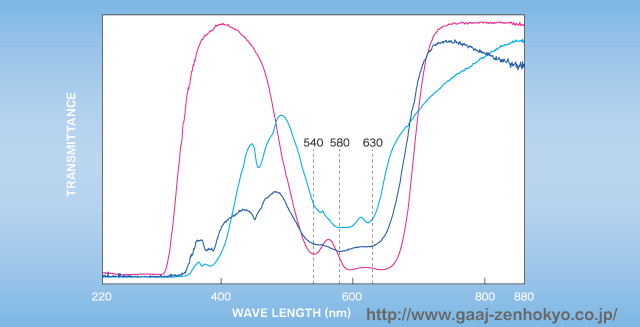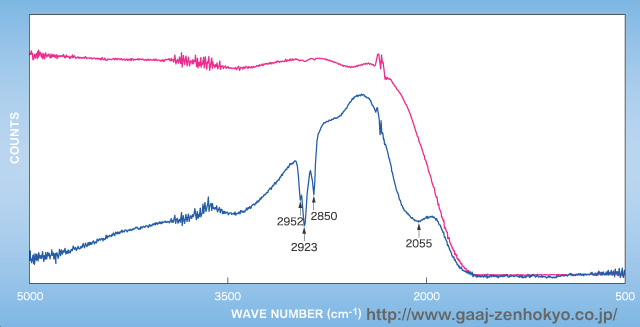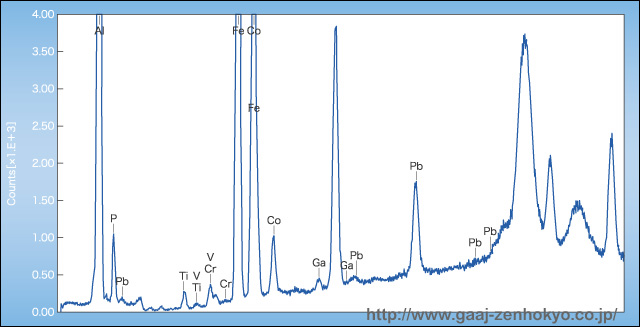|
<Absorption Spectra>
Spectral analysis in UV-Vis region showed distinct absorption bands on 630 nm, 580 nm and 540 nm, as well as faint absorptions on 450 nm and 388 nm. The former absorption bands, which were closely resembling spectra of Co-coloured blue spinel or glue glass, were assumed to originate in cobalt (figure 1). As a result of spectral measurements in infrared region by FTIR, a broad absorption around 2055 cm-1 together with strong absorptions on 2850, 2923 and 2952 cm-1 were recognised (figure 2). The absorption positions on 2850, 2923 and 2952 cm-1 coincide with those of oil/resin-related substance; however, no absorptions due to oil was recognised in Raman spectral analysis. In the wavelength range over 2500 cm-1 on their spectra, transparency seemed to become diminished towards higher wavelengths. Such characteristic absorption is not observed in ruby of filling treatment with lead glass.
<Chemical Composition> After fluorescent X-ray spectral analysis, other than the main element Al or trace elements Ti, V, Cr, Fe and Ga in a host sapphire, elements such as P, Co and Pb were detected from surface-reaching fractures (figure 3). Contents of Cr and Fe were higher than that in general blue sapphire, and this is assumedly due to foreign material just like P, Co or Pb. Further analysis by LA-ICP-MS was carried to detect light elements or trace elements more sophisticatedly. From the analysis on a surface-reaching fracture that were coloured in blue, elements such as, in order of higher contents, Si, Na, Ca, K, Fe, B, Ti, Li, Cr, Zn, Ba, Ni, Cu, Zr, La, Ce, Sr, Mg, V, Mn and Mo were detected other than P, Co and Pb that were already detected by X-ray fluorescence analysis. Among those elements, Si, Na, Ca, K, B and Li have also been detected in fractures in fissures filled ruby, while P, Mg, V, Cr, Mn, Fe, Ni, Cu, Zn, Sr, Zr, Mo, Ba, La and Ce were newly detected in the blue sapphire called "Super Diffution Tanusorn" tested here.
These newly detected elements closely resemble those originate in flux (Sodium tetraborate, Lithium metaborate, Sodium di-hydrogen phosphate etc.), which is an additive generally used in heating corundum, but their definite origin remain unknown. <Expression on the Gem Report> LMHC immediately discussed on the notation on gemmological reports for this new type of treated sapphire at the New York meeting held in October 2007 and confirmed that an item for colouring treatment shall be added to the established wording for fissures and cavities filled ruby. |
||||||||||||
|


